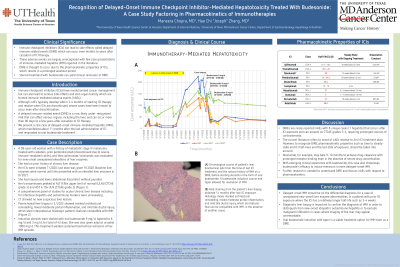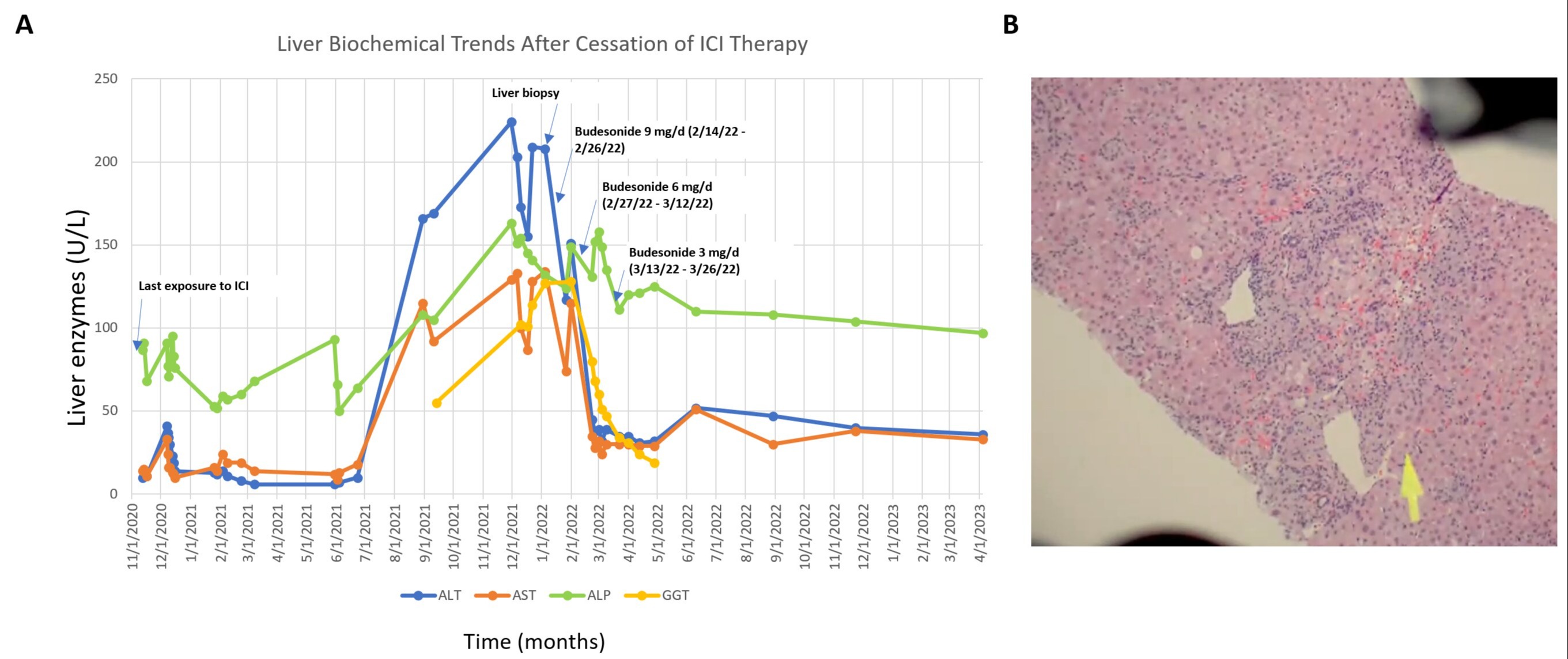Tuesday Poster Session
Category: Liver
P4024 - Recognition of Delayed-Onset Immune Checkpoint Inhibitor-Mediated Hepatotoxicity Treated With Budesonide: A Case Study Factoring in Pharmacokinetics of Immunotherapies
Tuesday, October 24, 2023
10:30 AM - 4:00 PM PT
Location: Exhibit Hall

Has Audio

Maneera Chopra, MD
University of Texas Health Science Center at Houston
Houston, TX
Presenting Author(s)
Maneera Chopra, MD1, Hao Chi Zhang, MD2
1University of Texas Health Science Center at Houston, Houston, TX; 2University of Texas MD Anderson Cancer Center, Houston, TX
Introduction: A delayed immune-related event (DIRE) is a rare, likely under-recognized, immune-related adverse event (irAE) that can affect various organs, including the liver, and can occur >90 days to a few years after cessation of immune checkpoint inhibitors (ICI). We present a rare case of delayed-onset immune-mediated hepatitis (IMH), which manifested about 11 months after the last administration of ICI and responded to oral budesonide treatment.
Case Description/Methods: A 58-year-old woman with a history of metastatic stage IV melanoma, treated with radiation, prior pembrolizumab (discontinued due to severe immune-mediated colitis), and then ipilimumab/nivolumab, was evaluated for unexplained elevations of liver enzymes. Her ICIs were initiated 7/2020; last dose was given 9/2020. The patient's baseline liver enzymes were normal until she presented with an increase in liver transaminases in 8/2021. She reported occasional nausea and lower abdominal discomfort but denied jaundice. She had no prior history of chronic liver disease. Her transaminases peaked at ALT 8.96x upper limit of normal (ULN) (CTCAE grade 3) and AST 4.19x ULN (CTCAE grade 2). Other serologic studies for liver disease including viral hepatitis and autoimmune markers were unrevealing. Abdominopelvic CT showed no new suspicious liver lesions. Parenchymal liver biopsy in 2/2022 showed marked architectural remodeling, mixed moderate portal inflammation, and mild bile ductal injury, which are features compatible with IMH. The patient was started on induction steroids with oral budesonide 9 mg/d with taper to 6 mg/d and 3 mg/d, for total of 42 days, and adjunct ursodiol 1000 mg/d, which yielded adequate liver biochemical remission.
Discussion: DIREs are rarely reported irAEs with 8 unique cases (1 hepatitis) that occurs after ICI exposure and can present as CTCAE grades 3-4, requiring prolonged courses of corticosteroids. The literature often discusses the onset of irAEs relative to first ICI treatment dose. However, to recognize DIRE, pharmacokinetic properties such as time to steady-state and ICI half-lives should be taken into count. Nivolumab, for example, may take more than 8 months to achieve drug clearance with prolonged receptor binding even in the absence of serum drug concentration. Finally, with emerging clinical experience with budesonide, this case also showcases budesonide's efficacy to induce remission in even delayed-onset IMH. Further research is needed to understand DIRE and discuss irAEs with respect to pharmacokinetics.

Disclosures:
Maneera Chopra, MD1, Hao Chi Zhang, MD2. P4024 - Recognition of Delayed-Onset Immune Checkpoint Inhibitor-Mediated Hepatotoxicity Treated With Budesonide: A Case Study Factoring in Pharmacokinetics of Immunotherapies, ACG 2023 Annual Scientific Meeting Abstracts. Vancouver, BC, Canada: American College of Gastroenterology.
1University of Texas Health Science Center at Houston, Houston, TX; 2University of Texas MD Anderson Cancer Center, Houston, TX
Introduction: A delayed immune-related event (DIRE) is a rare, likely under-recognized, immune-related adverse event (irAE) that can affect various organs, including the liver, and can occur >90 days to a few years after cessation of immune checkpoint inhibitors (ICI). We present a rare case of delayed-onset immune-mediated hepatitis (IMH), which manifested about 11 months after the last administration of ICI and responded to oral budesonide treatment.
Case Description/Methods: A 58-year-old woman with a history of metastatic stage IV melanoma, treated with radiation, prior pembrolizumab (discontinued due to severe immune-mediated colitis), and then ipilimumab/nivolumab, was evaluated for unexplained elevations of liver enzymes. Her ICIs were initiated 7/2020; last dose was given 9/2020. The patient's baseline liver enzymes were normal until she presented with an increase in liver transaminases in 8/2021. She reported occasional nausea and lower abdominal discomfort but denied jaundice. She had no prior history of chronic liver disease. Her transaminases peaked at ALT 8.96x upper limit of normal (ULN) (CTCAE grade 3) and AST 4.19x ULN (CTCAE grade 2). Other serologic studies for liver disease including viral hepatitis and autoimmune markers were unrevealing. Abdominopelvic CT showed no new suspicious liver lesions. Parenchymal liver biopsy in 2/2022 showed marked architectural remodeling, mixed moderate portal inflammation, and mild bile ductal injury, which are features compatible with IMH. The patient was started on induction steroids with oral budesonide 9 mg/d with taper to 6 mg/d and 3 mg/d, for total of 42 days, and adjunct ursodiol 1000 mg/d, which yielded adequate liver biochemical remission.
Discussion: DIREs are rarely reported irAEs with 8 unique cases (1 hepatitis) that occurs after ICI exposure and can present as CTCAE grades 3-4, requiring prolonged courses of corticosteroids. The literature often discusses the onset of irAEs relative to first ICI treatment dose. However, to recognize DIRE, pharmacokinetic properties such as time to steady-state and ICI half-lives should be taken into count. Nivolumab, for example, may take more than 8 months to achieve drug clearance with prolonged receptor binding even in the absence of serum drug concentration. Finally, with emerging clinical experience with budesonide, this case also showcases budesonide's efficacy to induce remission in even delayed-onset IMH. Further research is needed to understand DIRE and discuss irAEs with respect to pharmacokinetics.

Figure: (A) Graph showing liver biochemical lab trends after cessation of ipilimumab/nivolumab therapy. The patient demonstrated a significant elevation in liver enzymes about 11 months after ICIs were held, with the diagnosis of IMH confirmed by liver biopsy and considered a DIRE. After beginning treatment with oral budesonide with subsequent taper, the patient attained adequate clinical remission defined as ALT and AST <2x ULN. The ALT approached ULN, with complete normalization of AST and ALP. The differential diagnosis of IMH was still plausible at 11 months away from last ICI exposure due to knowledge of nivolumab's pharmacokinetics. Nivolumab has a half-life of 25 days, with steady state approached at about 12 weeks, and a dissociation constant of 1.45 nanomolar. Nivolumab's ability for PD-1 blockage can even persistent beyond 57 days even in the absence of detectable serum drug concentration. (B) Liver biopsy (H&E) showing marked architectural remodeling with areas of parenchymal collapse, mixed moderate portal inflammation with foci of lobular inflammation, endotheliitis, and evidence of mild bile duct injury. Abbreviations: ICI: immune checkpoint inhibitors; DIRE: delayed immune-related adverse event; ULN: upper limit of normal; AST: aspartate aminotransferase; ALT: alanine aminotransferase; ALP: alkaline phosphatase; GGT: gamma-glutamyl transferase.
Disclosures:
Maneera Chopra indicated no relevant financial relationships.
Hao Chi Zhang indicated no relevant financial relationships.
Maneera Chopra, MD1, Hao Chi Zhang, MD2. P4024 - Recognition of Delayed-Onset Immune Checkpoint Inhibitor-Mediated Hepatotoxicity Treated With Budesonide: A Case Study Factoring in Pharmacokinetics of Immunotherapies, ACG 2023 Annual Scientific Meeting Abstracts. Vancouver, BC, Canada: American College of Gastroenterology.

